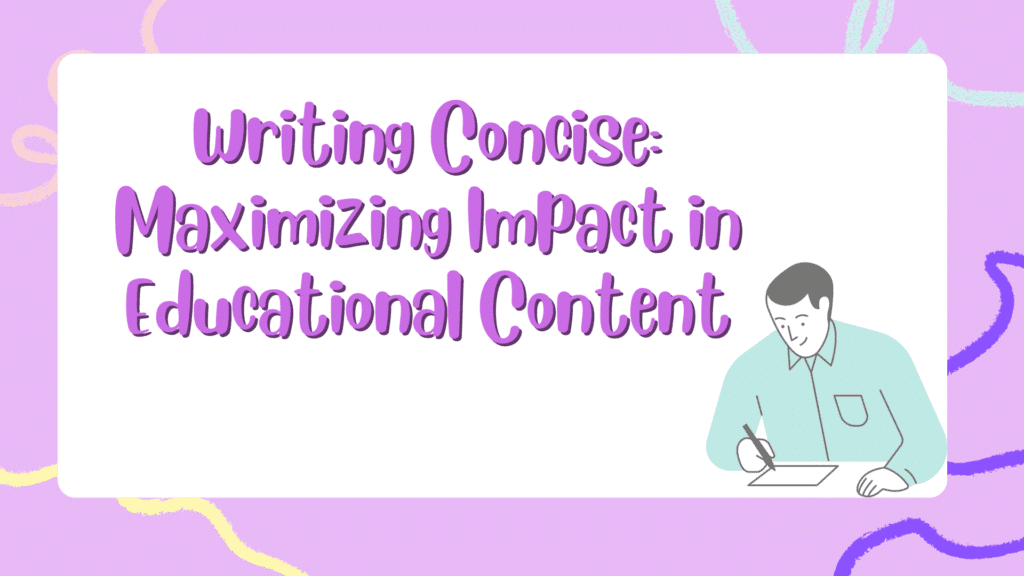Writing Concise: Maximizing Impact in Educational Content

What is educational content?
Educational content can be defined as any content that is written to serve an educational purpose. It can be an essay or a paper written by a teacher to explain a certain topic to the students, or it can even be a document highlighting the rules and regulations of a certain project, etc.
While educational content has an academic connotation to it, it can refer to any type of content that is written for teaching or educating the reader.
What is concise writing?
Moving on, let’s take a look at what concise writing is.
Concise writing is basically the type of writing that conveys a certain message or explains a certain topic in a few words. The word “concise” doesn’t exactly mean “short.” It can be better explained as “carrying a lot of meaning in a few words.”
There are different types of steps that you have to take to make your writing concise. We will talk about them in the coming headings.
What are the benefits of concise writing in educational content?
Now, let’s talk about the benefits of writing concisely when preparing educational content.
1. Concise content can be quickly and efficiently consumed by the reader
Educational content is for educating and teaching the readers about a particular topic or concept, etc. The quicker you are able to do that, the more positively your readers will take your content.
Concise content helps your readers go through it quickly while getting all the information that they need. That way, they will be able to read other stuff as well and get a better idea of the concept that they are trying to clear up.
2. Concise content is easier to save and retain
This is also an upside of making your content concise. The shorter and briefer your content is, the easier it is for your readers to save it (i.e., in the form of notes) and retain it in their minds.
By doing that, your readers will be able to take help and benefit from your content multiple times. They will be able to refer back to it when the need arises and read it again easily.
3. Concise content is easier to create and prepare
While there are numerous benefits of concise content for the reader, there are also some of the people writing it. If you prioritize brevity in your text, you will be able to write quickly without wasting a lot of time.
Dragging on long explanations and elaborations, for example, can require a lot of time and effort.
How can you write concisely?
After discussing the benefits of writing concisely, let’s move on to look at how you can actually do it.
1. Write in active voice
One of the most effective and actionable tips that we can proffer for concise writing is to always prioritize active voice over passive voice.
When you write in active voice, the length of the sentence is automatically shortened as compared to passive voice.
Consider the following example:
Jimmy started the car, and then John closed the door.
This is written in active voice, and it has 10 words. If we convert this to passive voice, it becomes:
The car was started by Jimmy, and then the door was closed by John.
In the passive voice version of the text, there are 14 words. That means, if you were to write 100 words in active voice, the same info could be conveyed in 140 words using passive voice. 1,400 words of passive voice content would be the equivalent of 1,000 words of active voice content.
2. Use descriptive words rather than long phrases
Although this sacrifices the simplicity and clarity of the content a little bit, it does help you keep it concise.
Instead of writing a long phrase (such as “eagle-like features”), you can shorten it down to a descriptive word (such as “aquiline features”). A lot of terms and phrases that are typically used in writing have a shorter substitute. You just need to broaden your vocabulary and find the right words for the situation.
3. Use online summarizing tools to shorten the content
Another way to shorten the content and make it concise is to use an online summarizing tool. Online summarizers, as they are called, analyze the content that they are provided, and then extract the key information from it. The key information is provided in the form of a summary, which is usually a third of the original length.
We don’t actually advise that you should write your entire content and then summarize it with a tool to shorten it. No, what we suggest is that you should write your content bit by bit and then summarize each part as you write it. That way, you can shorten the content as you go along and stay on top of any errors/imperfections that may arise during the summarization process.
Conclusion
On that note, we’re going to end our post here.
Writing concise content can be very helpful when you are writing for educational purposes. Educational content can be read and understood quickly when it is written with brevity. In the above post, we’ve looked at a few different tips and steps that you can follow to create such content with ease.